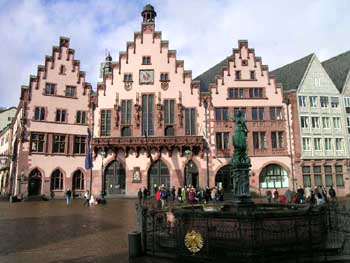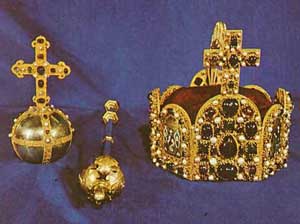 |
Organic Society
The Coronation Feast for the Emperor of the
Holy Roman German Empire
Hugh O’Reilly
From the time of Emperor Conrad to Ferdinand I, brother of Charles V, that is to say, from 911 to 1556, the imperial coronation took place in Aachen (Aix-la-Chapelle). In 1564 Maximilian I was the first of the series of Emperors who were elected and crowned in Frankfurt. From then on, the principal hall of the magnificent central building in Frankfurt, the Römer, which means the Roman, became the site for the proclamation of Emperors, in the room named the Kaisersaal, or Emperor Hall.

Above, the Romer in Frankfurt; below, the Kaisersaal
 |
The Kaisersaal is a long, large hall located above the Römerhalle on the second floor, discreetly illuminated on its eastern wall by five narrow windows opening to a balcony. In the Kaisersaal there is the finely carved leather table of the Elector Princes. Rows of paintings faded by time are on its four high walls. There, in the prestigious penumbra under the wooden ceiling with its ancient gold nervures, one finds the 45 portraits of the Emperors of the Carolingian Empire painted as if they were bronze statues; at their bases are plaques giving the dates of the beginning and end of each reign. Some of the sovereigns wear laurel branches on their heads like Roman Caesars, others are crowned with the German diadem.
There, silently, each from inside his niche, the Emperors gaze at one another: the three Conrads, the seven Henrys, the four Ottos, Lothar, the two Alberts, Louis, the four Charles who succeeded Charlemagne, Wenceslas, Robert, Sigismund, the two Maximilians, the three Ferdinands, Mathias, the two Leopolds, the two Josephs, and the two Francises, those Emperors who for nine centuries – from 911 to 1806 – made their mark in world History with the sword of St. Peter in one hand and the globe of Charlemagne in the other.
After the coronation ceremony took place in the Cathedral of St. Bartholomew, known as the Dom, the newly elected Emperor, followed by the Elector Princes, would process into the city square of Frankfurt, the Römer, moving toward the great hall in order to take part in the customary ceremonies of the occasion.
The Electors of Treveris, Moguncia and Cologne would take their places in the balcony at the first gallery window. They were the three ecclesiastical Elector Princes, the Archbishops of those cities.
The Emperor in solemn apparel – wearing the Imperial Mantle on his shoulders and the Crown on his head and carrying the Scepter and Globe – would take his place under the second gallery window.

The Orb, Scepter and Crown, insignia of the Holy Empire |
The third, the central one, had a canopy and was occupied by the Archbishop and clergy of Frankfurt. The fourth was destined for the Electors of Bohemia and Palatinate. The fifth was reserved for the Elector Princes of Saxony, Brandenburg and Brunswick.
After this brilliant assembly had assumed their places on the balcony, the entire square would break out in loud greetings and acclamations.
The commemorations in the square are worthy of special description: in the center of the square an ox was being roasted. On one side of the square was a fountain shaped like the imperial two-headed eagle. Through one of its beaks white wine poured, through the other, red wine. On the other side of the square stood a three-foot-tall mound of ground oats.
All the windows and balconies were decorated with ornate tapestries and banners. Then, when the Emperor, the Archbishops and the Electors were seated at their respective places, a trumpet would sound. The Grand Marshal – the official in charge of all the stables and horses of the Empire – would ride at gallop through the square to the mound of oats and fill a silver measuring cup, then return with it to the Kaisersaal and present the cup to the new Emperor. This signified that the stables of the Empire were well provided.

The Eagle of the Holy Roman German Empire displaying on its wings the shields of the Houses that belonged to it |
The trumpet would sound again, and the Grand Majordomo would gallop his horse to the fountain and fill two large chalices of the red and white wine and bring them to the Emperor. This symbolized that the cellars of the Holy Empire were filled with wine.
The trumpet would call a third time, and the Grand Steward would ride up to the roasted ox and cut off a piece to present to the Emperor. This signified that the kitchens of the Empire had abundant provisions.
Finally, the trumpet sounded a fourth time and the Grand Treasurer carrying a sack of gold and silver coins on horseback would ride slowly along the edges of the crowds and throw the coins out among the people. This was meant to express that the imperial treasury was full.
The return of the Grand Treasurer to his place was the signal for the people to enter the space reserved for the ceremony and begin their tournament for the mound of oats, the wine and the ox. Normally the butcher and the cooks would fight for the ox. Its head was the most honorable trophy of the battle. To this day, cooks display in the kitchens of palaces, and butchers in their marketplaces, the heads won by their forefathers in the memorable competitions of the imperial coronations.
Based on and translated from Alexandre Dumas, La Terreur Prussiène,
Paris: Calmann Levy, 1887, vol.1, pp. 261-262

Posted May 23, 2007

Related Topics of Interest
 Vocations of the European Peoples Vocations of the European Peoples
 What is Organic Society? What is Organic Society?
 Organic Society and Desire of Heaven Organic Society and Desire of Heaven
 The Moon and its Halo The Moon and its Halo
 Paradise: A Heavenly Court Paradise: A Heavenly Court
 Departure for the Crusade: A Desire for Sublimity Departure for the Crusade: A Desire for Sublimity
 The Role of Admiration The Role of Admiration

|
Organic Society | Social-Political | Home | Books | CDs | Search | Contact Us

© 2002- Tradition in Action, Inc. All Rights Reserved
|
 |
|